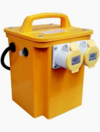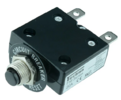- Joined
- 27 Jan 2008
- Messages
- 24,903
- Reaction score
- 2,877
- Location
- Llanfair Caereinion, Nr Welshpool
- Country

Most will have guessed the subject
 with a 10 amp overload they can deliver 41.8 amps when one line is shorted to earth for a very long time without anything tripping, common to find extension plugged into extension so the cable is that long there is insufficient current at 230 volt to open a 10 amp overload, but there is over 40 amps at 55 volt.
with a 10 amp overload they can deliver 41.8 amps when one line is shorted to earth for a very long time without anything tripping, common to find extension plugged into extension so the cable is that long there is insufficient current at 230 volt to open a 10 amp overload, but there is over 40 amps at 55 volt.
Where I work in the main they are used to supply 110 volt lighting, most power tools are battery or 230 volt, it is not a building site, so there is no rules saying 110 (55-0-55 or 64-0-64) volt must be used, but in a building which leaks like a sieve, reduced low voltage lighting is considered better.
Power tools do not present such a problem and the cables are run out for a job, then collected again once finished, but lighting can easy be left on for an extended time, and possibly no one would notice it had failed.
So with inspection and testing of in service electrical equipment would you pass it? And what would be the reason given if failing it, assuming in an as new condition?
 with a 10 amp overload they can deliver 41.8 amps when one line is shorted to earth for a very long time without anything tripping, common to find extension plugged into extension so the cable is that long there is insufficient current at 230 volt to open a 10 amp overload, but there is over 40 amps at 55 volt.
with a 10 amp overload they can deliver 41.8 amps when one line is shorted to earth for a very long time without anything tripping, common to find extension plugged into extension so the cable is that long there is insufficient current at 230 volt to open a 10 amp overload, but there is over 40 amps at 55 volt.Where I work in the main they are used to supply 110 volt lighting, most power tools are battery or 230 volt, it is not a building site, so there is no rules saying 110 (55-0-55 or 64-0-64) volt must be used, but in a building which leaks like a sieve, reduced low voltage lighting is considered better.
Power tools do not present such a problem and the cables are run out for a job, then collected again once finished, but lighting can easy be left on for an extended time, and possibly no one would notice it had failed.
So with inspection and testing of in service electrical equipment would you pass it? And what would be the reason given if failing it, assuming in an as new condition?

